A Parallel Evolutionary Computing-Embodied Artificial Neural Network Applied to Non-Intrusive Load Monitoring for Demand-Side Management in a Smart Home: Towards Deep Learning
Abstract
1. Introduction
- In contrast to the work that was finished in References [12,20,21], this work develops and applies a parallel GA to meta-heuristically evolve a feed-forward ANN, in order to achieve its optimal adjustable parameters, optimal trainable weight coefficients including biases, and speed up the evolutionary process for meta-heuristically training the connectionism for load classification in NILM conducted as a part of a Home Energy Management System (HEMS) for Demand-Side Management (DSM). The developed parallel GA-embodied ANN is a revision of the methodology that was done in Reference [12]. In addition, it is a preliminary design of NILM toward deep learning.
- NILM addressed in this work is a fully-nonintrusive alternative that, during the preliminary stage of NILM involving the training process of load classification, no instrumentation for (rated) power consumption on each electrical appliance is required. It is suggested that, in the preliminary stage of NILM, collected data that need to be learned for load classification can be labeled in a sensor fusion fashion. Through the NILM with respect to aggregated electric energy consumption, electrical appliances for their electric power consumption can be deduced/statistically estimated.
2. Methodology
2.1. HEMS
2.2. NILM Based on a Parallel GA-Embodied ANN to Fully-Nonintrusively Identify Electrical Appliances Consuming Electric Power
2.2.1. ANN
2.2.2. GA
- Selection selects chromosomes based on a fitness-based selection/proportional selection procedure and fitter solutions (with relatively high fitness) are typically more likely to be selected (candidate solutions are evaluated through a fitness function),
- crossover exchanges subparts of two chromosomes, roughly mimicking biological recombination between two haploid organisms, and
- mutation randomly alters values of genes in some chromosomes. An arbitrary bit of a chromosome is changed from its original state. In a GA, the population size depends on the nature of the problem addressed, but, typically, the population contains several hundreds or thousands of chromosomes/candidate solutions. Chromosomes are generated at random in the initial population. The generational process is repeated until a termination condition has been met. For example, the generational process will terminate when the pre-specified maximum number of generations is reached.
2.2.3. Parallel Evolutionary Computing-Parallel GA
- creates a random binary vector as a mask,
- picks genes from the first parent, where indexing of the created vector is 1s,
- picks genes from the second parent, where indexing of the created vector is 0s, and
- combines the genes to form a new individual as a new/potential ANN for load classification in NILM. The scattered crossover is illustrated in Figure 8.
3. Experiment
- Input layer: the total number of artificial neurons in the input layer of the connectionism is 2 due to the two extracted electrical features, P and Q. Each artificial neuron in this layer comes with an identity-style activation function. Training samples conveyed to the connectionism are normalized within the interval [−1, 1].
- Hidden layer: only one single hidden layer is considered. It consists of 25 artificial neurons. Each artificial neuron in this layer is aroused with a sigmoid-style activation function. That is, artificial neurons used in this layer are the most basic computational sigmoid neurons [46,47] (there are many other nonlinear formulas, nonlinearities, that can be implemented as nonlinear activation functions for feed-forward multi-layer ANNs). In deep NNs conducting a many-layered structure of hidden layers, one shortcoming of the sigmoid neurons is the gradient vanishing problem [46,47,48].
- Output layer: the total number of artificial neurons in the output layer of the connectionism is 4 due to the four electrical appliances monitored. Each artificial neuron in this layer serves as an appliance indicator that the operational ON/OFF status of the electrical appliances, at time slice t, is indicated. Its output is based on the round() function rounding its input argument to the nearest integer 0 (indicating status OFF) or 1 (indicating status ON). The style of the activation functions used by the artificial neurons in this layer is the same as that of the activation functions used by the artificial neurons in the hidden layer.
- Cost function: averaged Sum of Squared Errors (SSE) is adopted. In this experiment, a parallel GA instead of the widely-used GD algorithm is conducted and used to train the configured feed-forward ANN/connectionism. The configured feed-forward ANN is evolved, which is parallelized.
4. Discussion
5. Conclusions
Author Contributions
Funding
Acknowledgments
Conflicts of Interest
Appendix A


Appendix B


References
- Hart, G.W. Nonintrusive appliance load monitoring. Proc. IEEE 1992, 80, 1870–1891. [Google Scholar] [CrossRef]
- Hosseini, S.S.; Agbossou, K.; Kelouwani, S.; Cardenas, A. Non-intrusive load monitoring through home energy management systems: A comprehensive review. Renew. Sustain. Energy Rev. 2017, 79, 1266–1274. [Google Scholar] [CrossRef]
- He, H.; Lin, X.; Xiao, Y.; Qian, B.; Zhou, H. Optimal strategy to select load identification features by using a particle resampling algorithm. Appl. Sci. 2019, 9, 2622. [Google Scholar] [CrossRef]
- Batra, N.; Singh, A.; Whitehouse, K. If you measure it, can you improve it? Exploring the value of energy disaggregation. In Proceedings of the 2nd ACM International Conference on Embedded Systems for Energy-Efficient Built Environments/ACM BuildSys’15, Seoul, Korea, 4–5 November 2015; pp. 191–200. [Google Scholar]
- Froehlich, J.; Larson, E.; Gupta, S.; Cohn, G.; Reynolds, M.; Patel, S. Disaggregated end-use energy sensing for the smart grid. IEEE Pervasive Comput. 2011, 10, 28–39. [Google Scholar] [CrossRef]
- Zhao, B.; Stankovic, L.; Stankovic, V. On a training-less solution for non-intrusive appliance load monitoring using graph signal processing. IEEE Access 2016, 4, 1784–1799. [Google Scholar] [CrossRef]
- Lin, Y.H.; Tsai, M.S. An advanced home energy management system facilitated by nonintrusive load monitoring with automated multiobjective power scheduling. IEEE Trans. Smart Grid 2015, 6, 1839–1851. [Google Scholar] [CrossRef]
- Mueller, J.A.; Kimball, J.W. Accurate energy use estimation for nonintrusive load monitoring in systems of known devices. IEEE Trans. Smart Grid 2018, 9, 2797–2808. [Google Scholar] [CrossRef]
- Kong, W.; Dong, Z.Y.; Ma, J.; Hill, D.J.; Zhao, J.; Luo, F. An extensible approach for non-intrusive load disaggregation with smart meter data. IEEE Trans. Smart Grid 2018, 9, 3362–3372. [Google Scholar] [CrossRef]
- Lin, Y.H. Design and implementation of an IoT-oriented energy management system based on non-intrusive and self-organizing neuro-fuzzy classification as an electrical energy audit in smart homes. Appl. Sci. 2018, 8, 2337. [Google Scholar] [CrossRef]
- Wu, X.; Gao, Y.; Jiao, D. Multi-label classification based on random forest algorithm for non-intrusive load monitoring system. Processes 2019, 7, 337. [Google Scholar] [CrossRef]
- Lin, Y.H.; Hu, Y.C. Electrical energy management based on a hybrid artificial neural network-particle swarm optimization-integrated two-stage non-intrusive load monitoring process in smart homes. Processes 2018, 6, 236. [Google Scholar] [CrossRef]
- Lin, Y.H.; Hu, Y.C. Residential consumer-centric demand-side management based on energy disaggregation-piloting constrained swarm intelligence: Towards edge computing. Sensors 2018, 18, 1365. [Google Scholar] [CrossRef] [PubMed]
- Qi, B.; Liu, L.; Wu, X. Low-Rate Non-Intrusive Load Disaggregation with Graph Shift Quadratic Form Constraint. Appl. Sci. 2018, 8, 554. [Google Scholar] [CrossRef]
- Zheng, Z.; Chen, H.; Luo, X. A Supervised Event-Based Non-Intrusive Load Monitoring for Non-Linear Appliances. Sustainability 2018, 10, 1001. [Google Scholar] [CrossRef]
- Schirmer, P.A.; Mporas, I. Statistical and electrical features evaluation for electrical appliances energy disaggregation. Sustainability 2019, 11, 3222. [Google Scholar] [CrossRef]
- Fagiani, M.; Bonfigli, R.; Principi, E.; Squartini, S.; Mandolini, L. A non-intrusive load monitoring algorithm based on non-uniform sampling of power data and deep neural networks. Energies 2019, 12, 1371. [Google Scholar] [CrossRef]
- Kelly, J.; Knottenbelt, W. Neural NILM: Deep neural networks applied to energy disaggregation. In Proceedings of the 2nd ACM International Conference on Embedded Systems for Energy-Efficient Built Environments/ACM BuildSys’15, Seoul, Korea, 4–5 November 2015; pp. 55–64. [Google Scholar]
- Çavdar, İ.H.; Faryad, V. New design of a supervised energy disaggregation model based on the deep neural network for a smart grid. Energies 2019, 12, 1217. [Google Scholar] [CrossRef]
- Chang, H.H. Non-intrusive demand monitoring and load identification for energy management systems based on transient feature analyses. Energies 2012, 5, 4569–4589. [Google Scholar] [CrossRef]
- Chang, H.H.; Chen, K.L.; Tsai, Y.P.; Lee, W.J. A new measurement method for power signatures of non-intrusive demand monitoring and load identification. IEEE Trans. Ind. Appl. 2012, 48, 764–771. [Google Scholar] [CrossRef]
- Rashid, H.; Singh, P.; Stankovic, V.; Stankovic, L. Can non-intrusive load monitoring be used for identifying an appliance’s anomalous behavior? Appl. Energy 2019, 238, 796–805. [Google Scholar] [CrossRef]
- Zhou, B.; Li, W.; Chan, K.W.; Cao, Y.; Kuang, Y.; Liu, X.; Wang, X. Smart home energy management systems: Concept, configurations, and scheduling strategies. Renew. Sustain. Energy Rev. 2016, 61, 30–40. [Google Scholar] [CrossRef]
- Lin, Y.H.; Tsai, M.S. Non-intrusive load monitoring by novel neuro-fuzzy classification considering uncertainties. IEEE Trans. Smart Grid 2014, 5, 2376–2384. [Google Scholar] [CrossRef]
- Ramya, C.M.; Shanmugaraj, M.; Prabakaran, R. Study on ZigBee technology. In Proceedings of the 3rd International Conference on Electronics Computer Technology (ICECT), Kanyakumari, India, 8–10 April 2011; Volume 6, pp. 297–301. [Google Scholar]
- Qivicon Smart Home Alliance. Available online: https://www.qivicon.com (accessed on 25 July 2018).
- Gao, L.; Wang, Z.X.; Zhou, J.; Zhang, C. Design of smart home system based on ZigBee technology and R&D for application. Energy Power Eng. 2016, 8, 13–22. [Google Scholar] [CrossRef]
- Froiz-Míguez, I.; Fernández-Caramés, T.M.; Fraga-Lamas, P.; Castedo, L. Design, implementation and practical evaluation of an IoT home automation system for fog computing applications based on MQTT and ZigBee-WiFi sensor nodes. Sensors 2018, 18, 2660. [Google Scholar] [CrossRef]
- Ullah, I.; Kim, D. An optimization scheme for water pump Control in smart fish farm with efficient energy consumption. Processes 2018, 6, 65. [Google Scholar] [CrossRef]
- Rafsanjani, H.N.; Ghahramani, A. Extracting occupants’ energy-use patterns from Wi-Fi networks in office buildings. J. Build. Eng. 2019, 26, 100864. [Google Scholar] [CrossRef]
- Le, T.-T.-H.; Kim, H. Non-intrusive load monitoring based on novel transient signal in household appliances with low sampling rate. Energies 2018, 11, 3409. [Google Scholar] [CrossRef]
- Guillén-García, E.; Morales-Velazquez, L.; Zorita-Lamadrid, A.L.; Duque-Perez, O.; Osornio-Rios, R.A.; de Jesús Romero-Troncoso, R. Identification of the electrical load by C-means from non-intrusive monitoring of electrical signals in non-residential buildings. Int. J. Electr. Power Energy Syst. 2019, 104, 21–28. [Google Scholar] [CrossRef]
- McCulloch, W.S.; Pitts, W. A logical calculus of the ideas immanent in nervous activity. Bull. Math. Biophys. 1943, 5, 115–133. [Google Scholar] [CrossRef]
- Ai, S. Domestic Electricity Demand and Peak Predictions Considering Influence of Weather Parameters. Master’s Thesis, University of Agder, Agder, Norway, 2015. [Google Scholar]
- Nielsen, M. Neural Networks and Deep Learning; Determination Press: San Francisco, CA, USA, 2015. [Google Scholar]
- Ai, S.; Chakravorty, A.; Rong, C. Household power demand prediction using evolutionary ensemble neural network pool with multiple network structures. Sensors 2019, 19, 721. [Google Scholar] [CrossRef]
- Chen, Y.Y.; Lin, Y.H. A smart autonomous time- and frequency-domain analysis current sensor-based power meter prototype developed over fog-cloud analytics for demand-side management. Sensors 2019, 19, 4443. [Google Scholar] [CrossRef] [PubMed]
- Ruano, A.; Hernandez, A.; Ureña, J.; Ruano, M.; Garcia, J. NILM techniques for intelligent home energy management and ambient assisted living: A review. Energies 2019, 12, 2203. [Google Scholar] [CrossRef]
- Hong, Y.Y.; Chen, B.Y. Locating switched capacitor using wavelet transform and hybrid principal component analysis network. IEEE Trans. Power Deliver. 2007, 22, 1145–1152. [Google Scholar] [CrossRef]
- Huang, G.B.; Babri, H. Upper bounds on the number of hidden neurons in feedforward networks with arbitrary bounded nonlinear activation functions. IEEE Trans. Neural Networ. 1998, 9, 224–229. [Google Scholar] [CrossRef]
- Lin, C.T.; Lee George, C.S. Neural Fuzzy Systems: A Neuro-Fuzzy Synergism to Intelligent Systems; International Edition; Prentice Hall (Pearson Education Taiwan Ltd.): Taipei, Taiwan, 2003; pp. 224–250. [Google Scholar]
- Cauchy, A. Méthode générale pour la résolution des systèmes d’équations simultanées. Comp. Rend. Acad. Sci. (Paris) 1847, 25, 536–538. [Google Scholar]
- Lin, C.T.; Lee George, C.S. Neural Fuzzy Systems: A Neuro-Fuzzy Synergism to Intelligent Systems; International Edition; Prentice Hall (Pearson Education Taiwan Ltd.): Taipei, Taiwan, 2003; pp. 382–406. [Google Scholar]
- Gen, M.; Cheng, R. Genetic Algorithms & Engineering Design, 1st ed.; John Wiley & Sons, Inc. (Wiley-InterScience): Hoboken, NJ, USA, 1997; pp. 1–41. [Google Scholar]
- Mahajan, R.; Kaur, G. Neural networks using genetic algorithms. Int. J. Comput. Appl. Technol. 2014, 77, 6–11. [Google Scholar] [CrossRef]
- Neural Networks and Deep Learning. Available online: http://neuralnetworksanddeeplearning.com/ (accessed on 22 January 2020).
- Hatcher, W.G.; Yu, W. A survey of deep learning: Platforms, applications and emerging research trends. IEEE Access 2018, 6, 24411–24432. [Google Scholar] [CrossRef]
- Jia, F.; Lei, Y.; Lu, N.; Xing, S. Deep normalized convolutional neural network for imbalanced fault classification of machinery and its understanding via visualization. Mech. Syst. Signal Proc. 2018, 110, 349–367. [Google Scholar] [CrossRef]
- Nielsen, M.A. Neural Networks and Deep Learning; Determination Press: San Francisco, CA, USA, 2015; pp. 35–37. [Google Scholar]
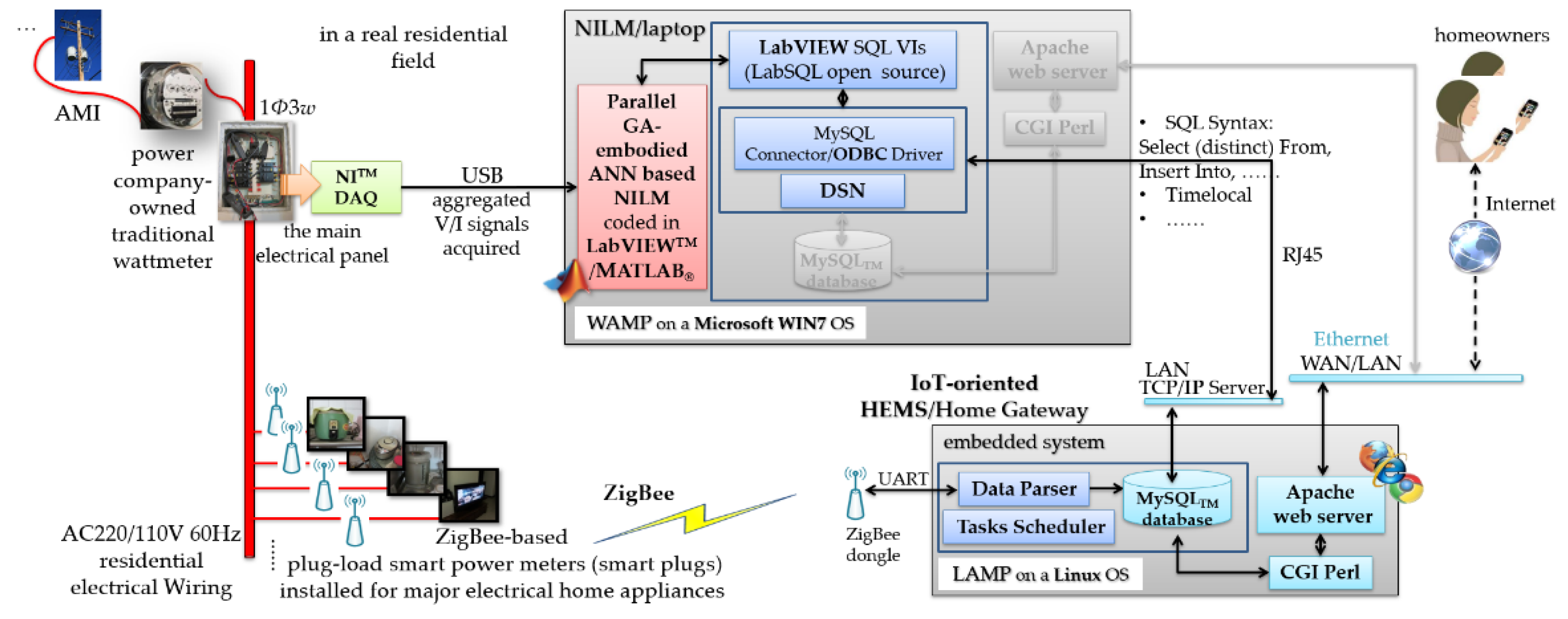
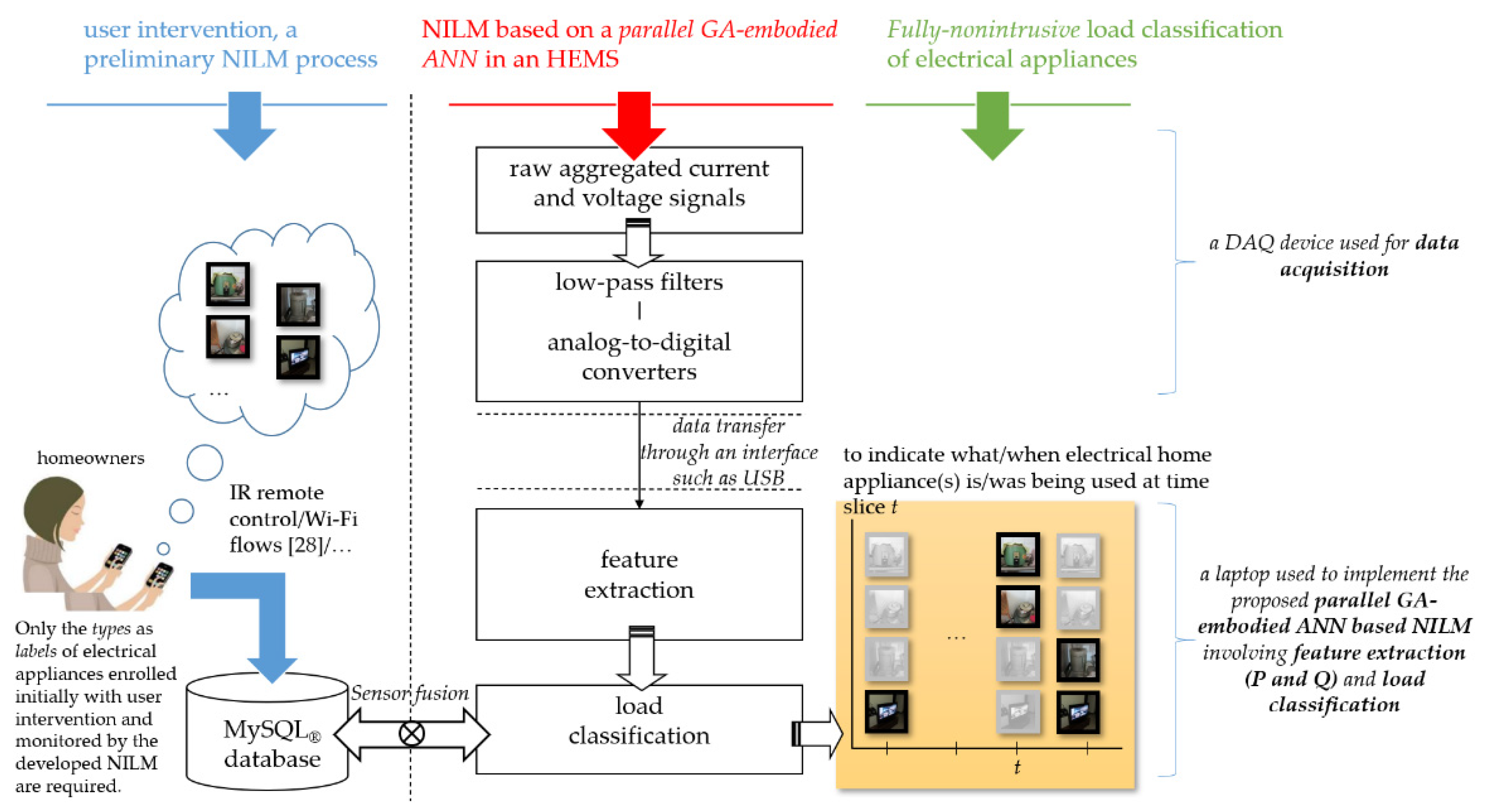
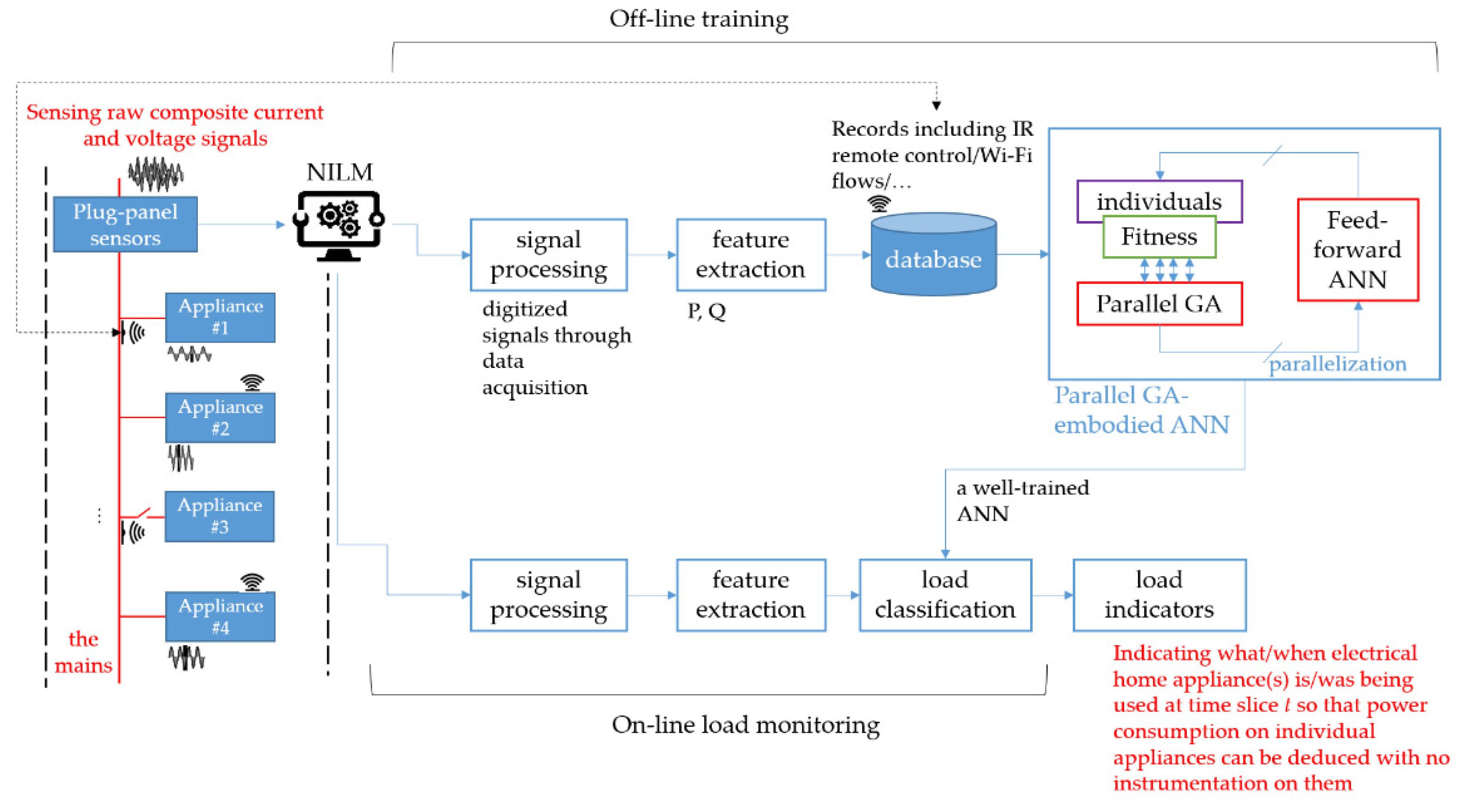


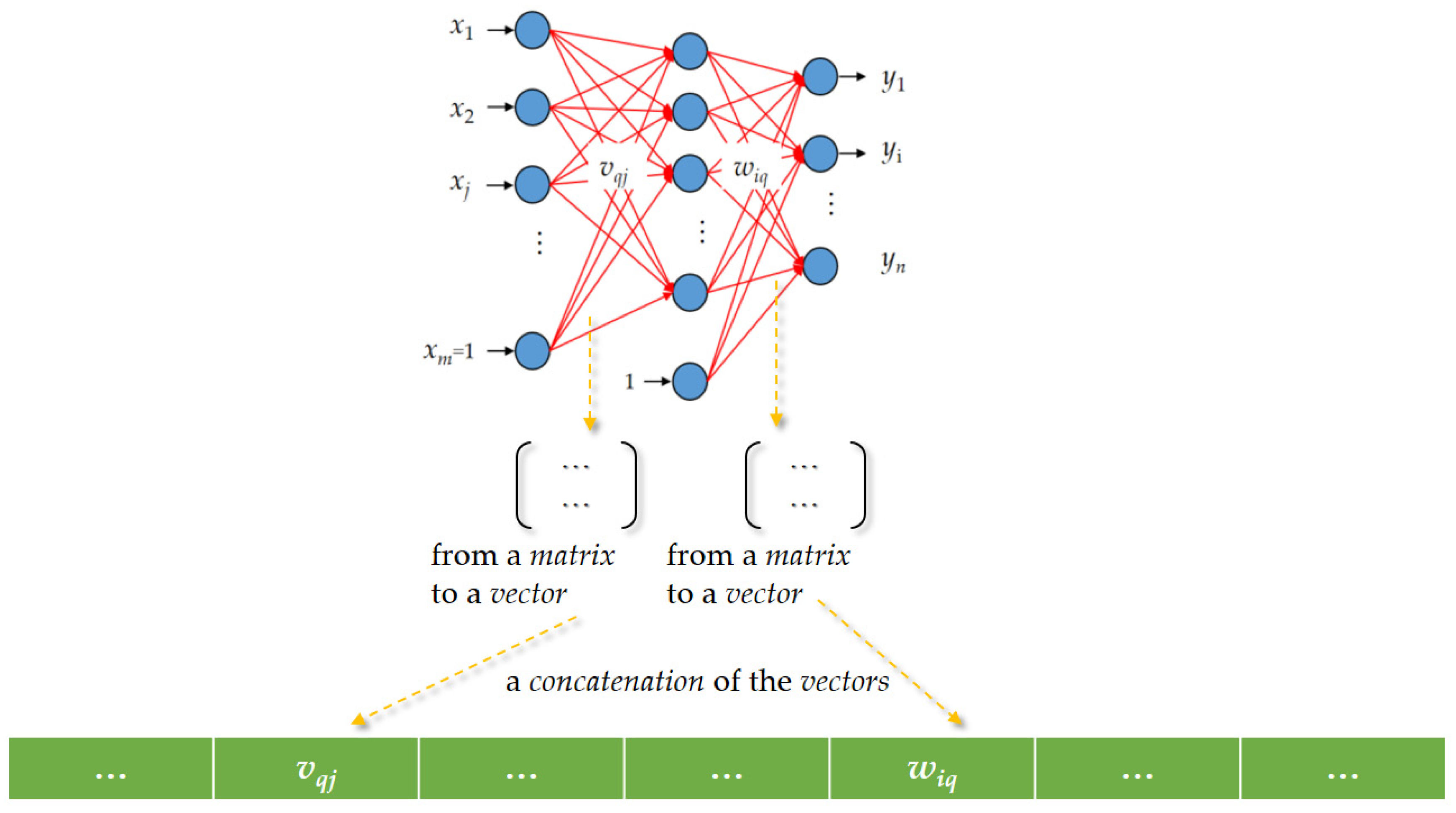
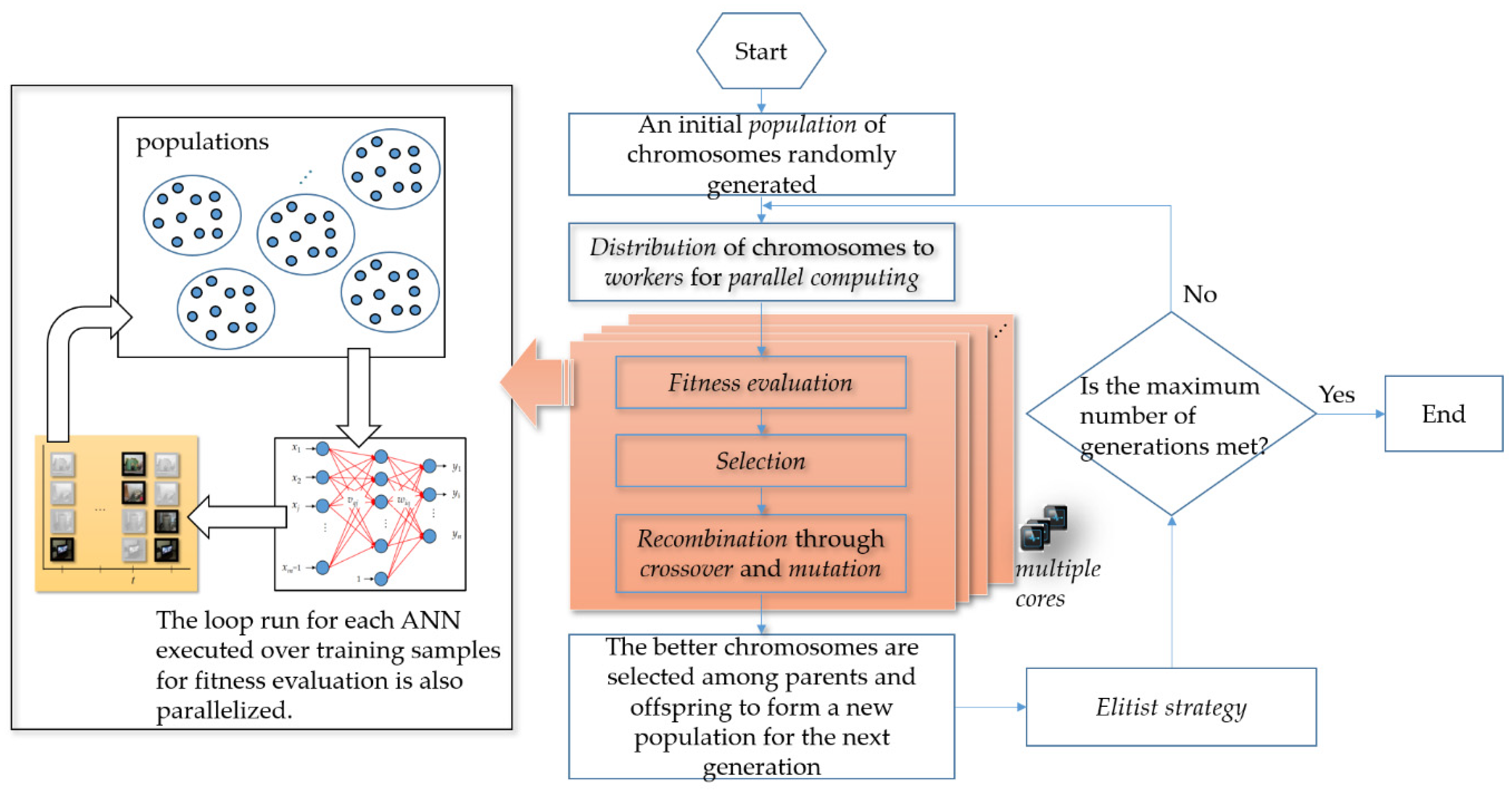
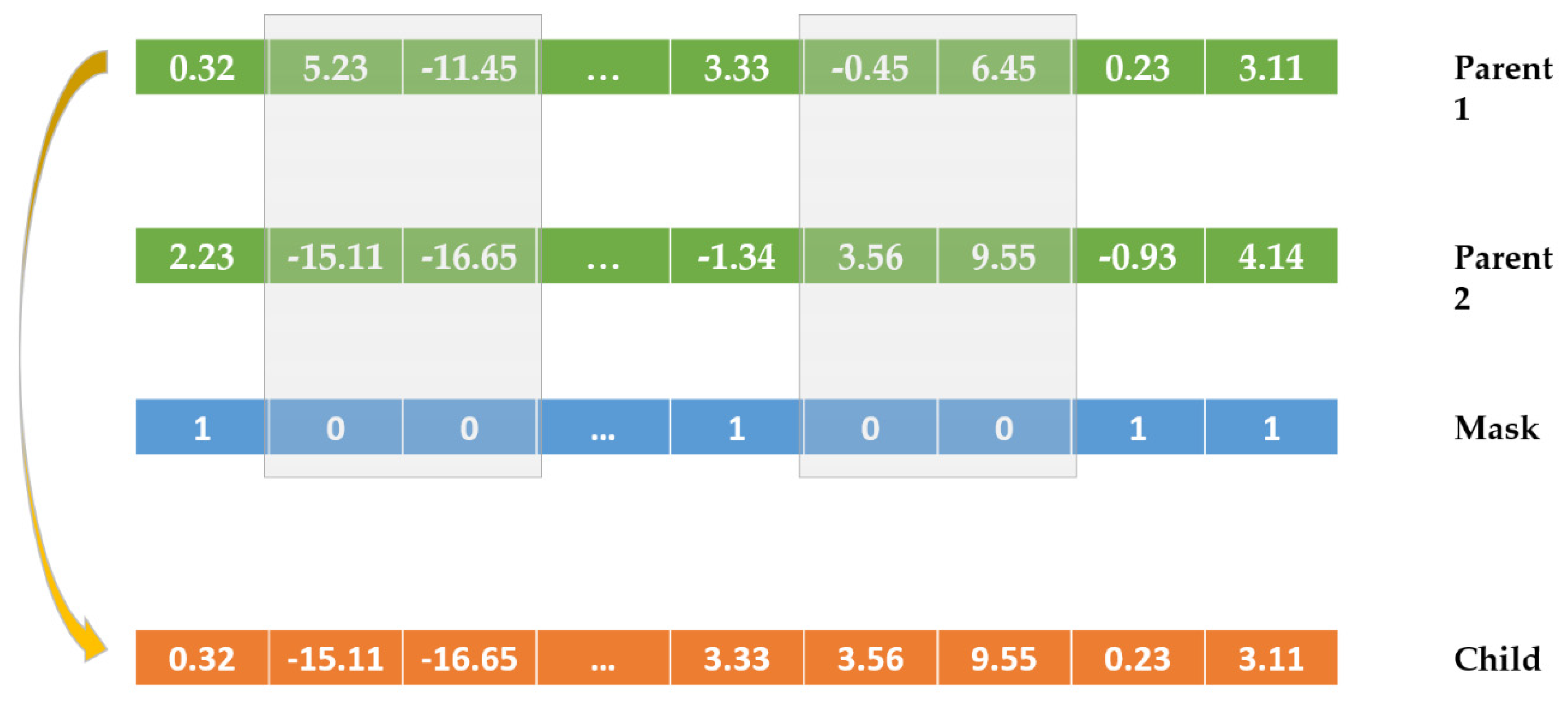
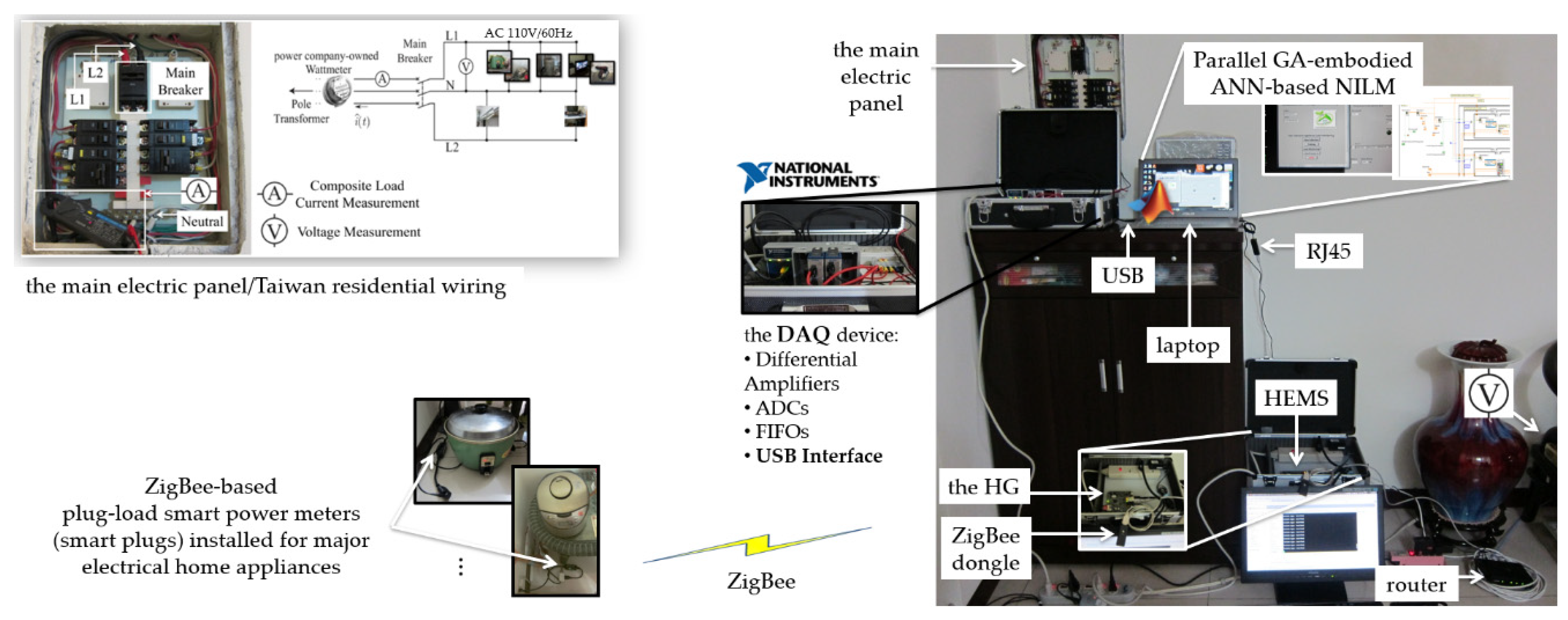
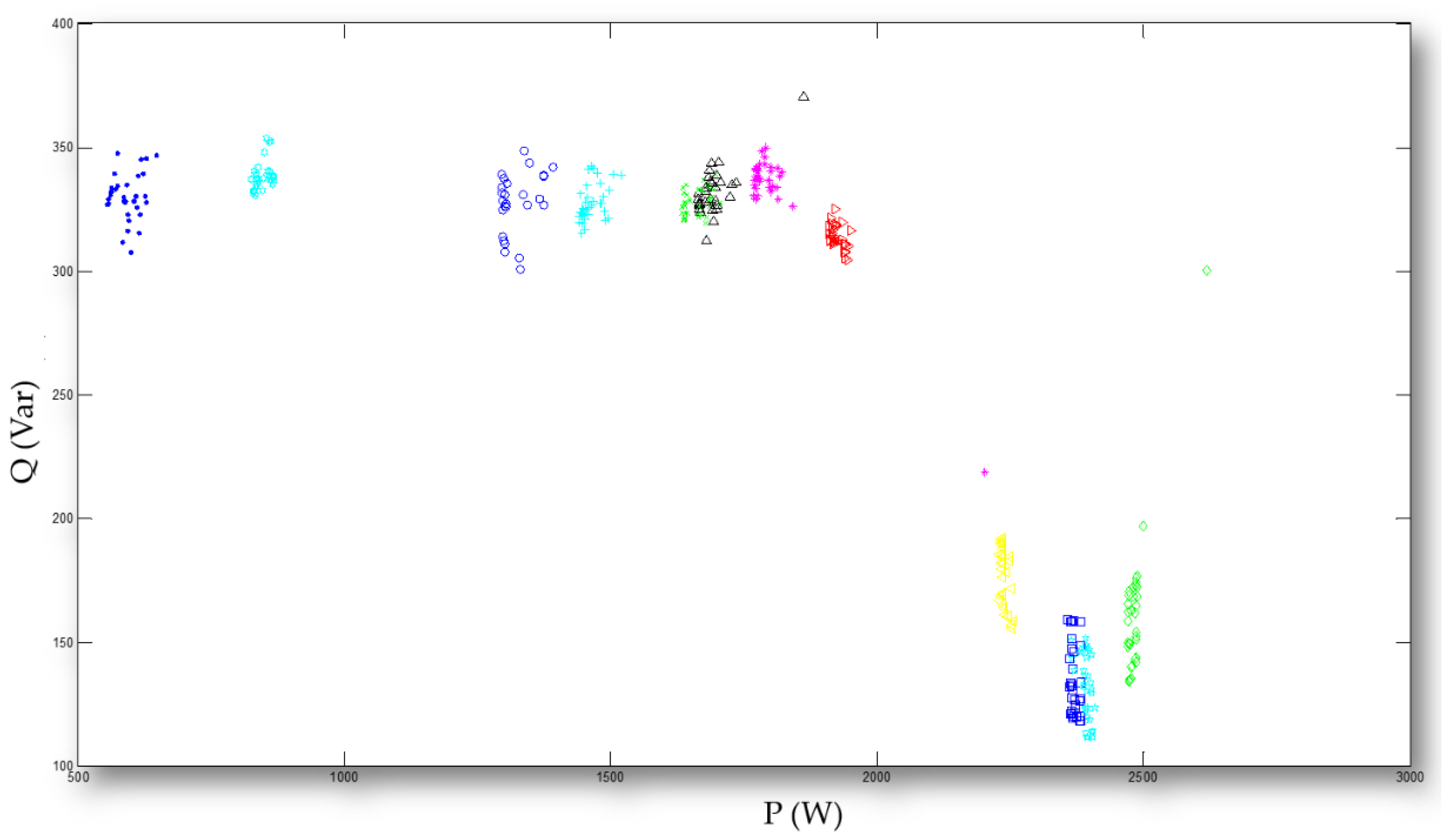
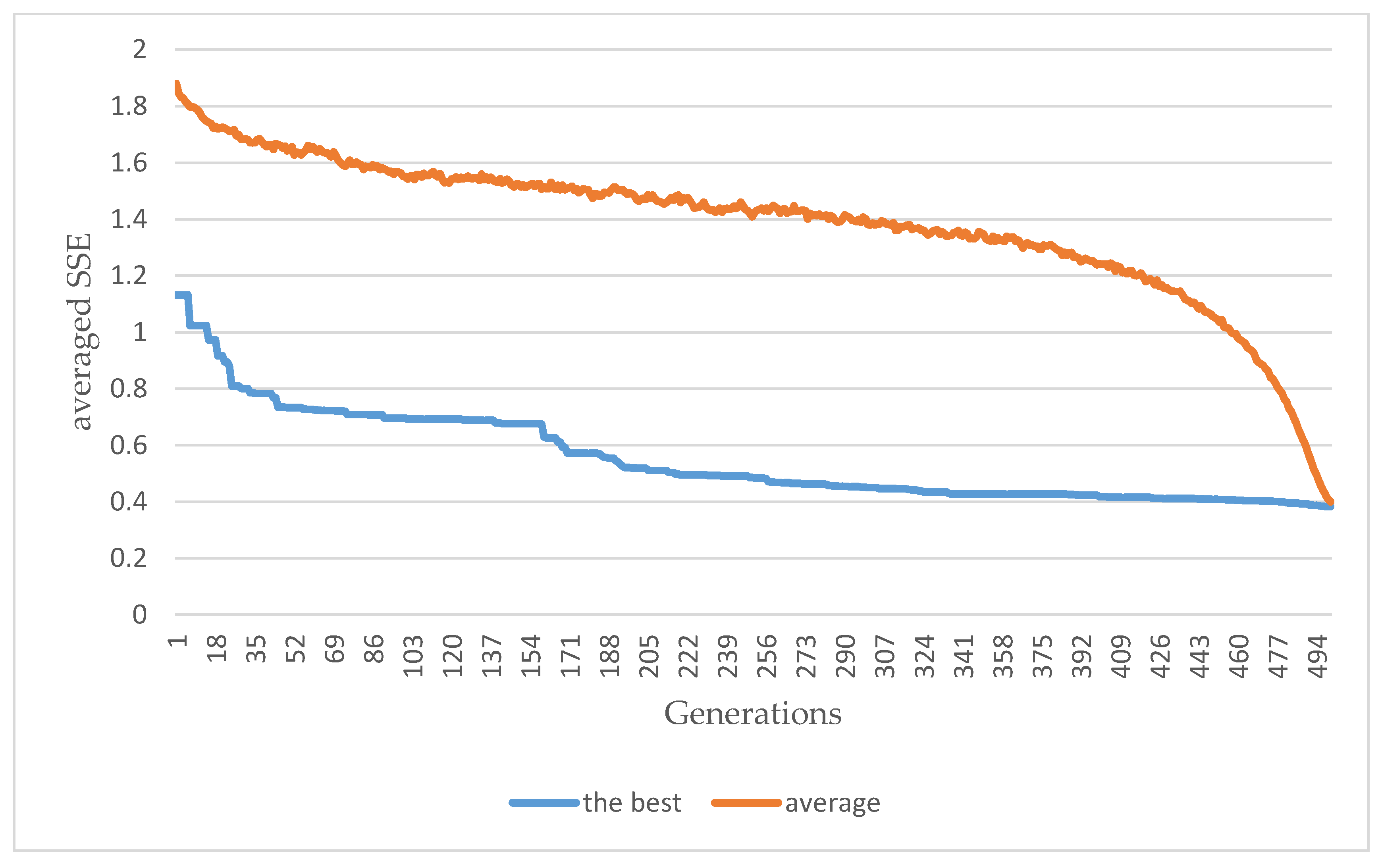
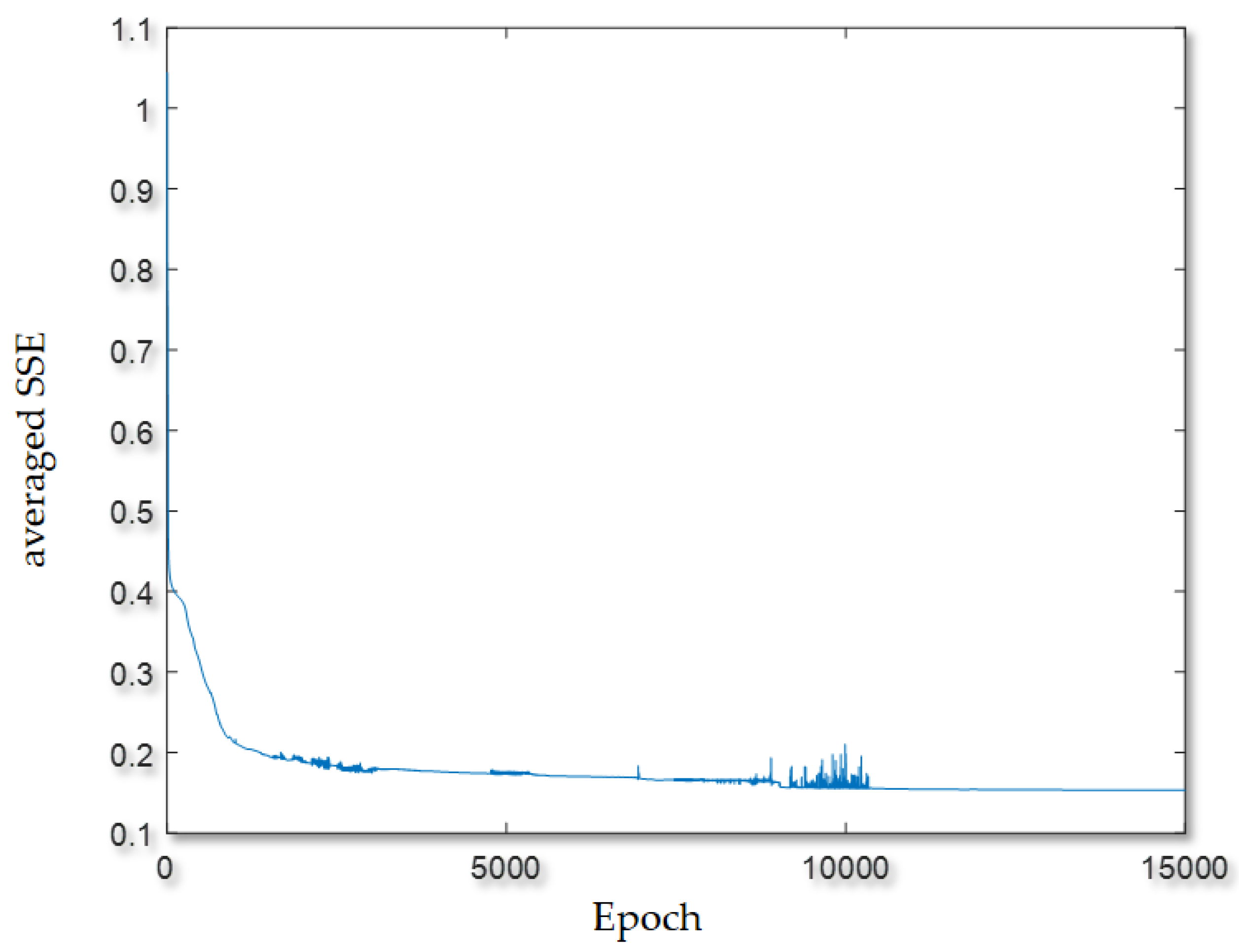
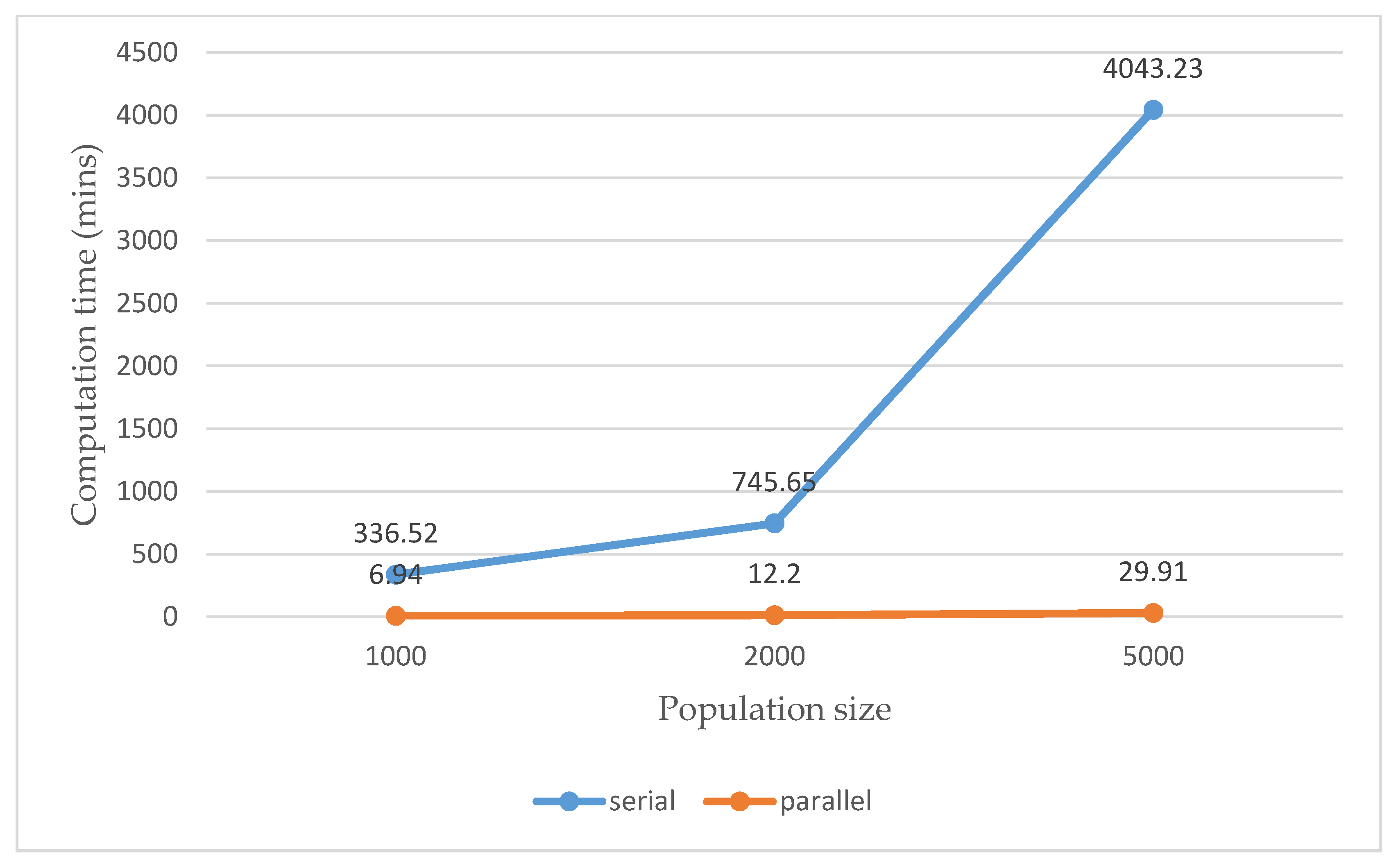
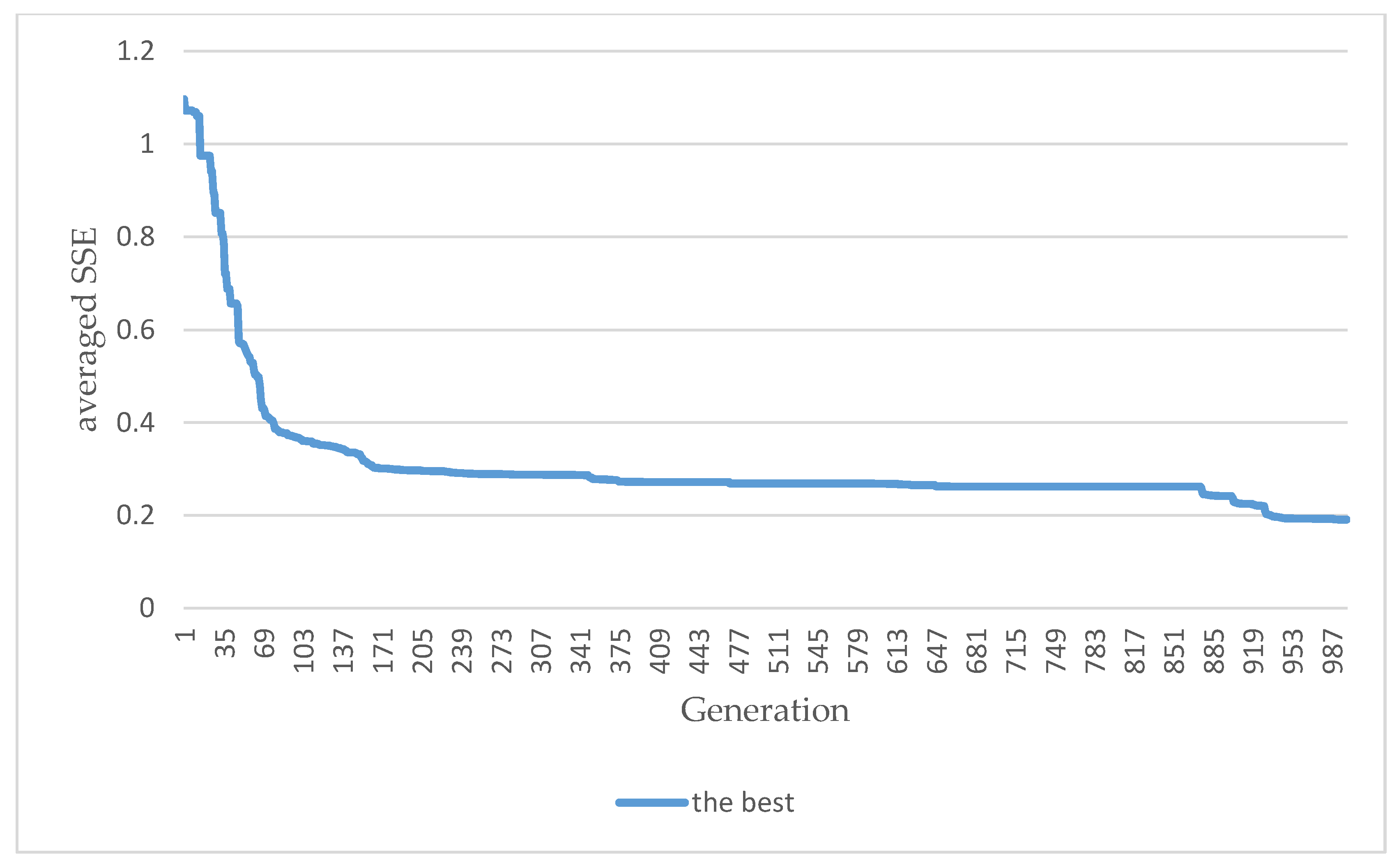
| Electrical Appliances | Load Classification Rates by Different AI Approaches (%) | Improvement in Load Classification Rate (%) | ||
|---|---|---|---|---|
| the configured ANN trained by the GD algorithm | the configured ANN evolved by a standard GA | the configured ANN evolved by the parallel GA | ||
| electric rice cooker | 94.06 | 74.06 | 85.62 | −8.44 |
| electric water boiler | 44.27 | 79.17 | 92.81 | +48.54 |
| steamer | 55.73 | 88.54 | 90.10 | +34.37 |
| TV | 47.19 | 89.69 | 83.23 | +36.04 |
| Computation time (mins) | 6.68 | 336.52 2 | 6.94 | - |
| Improvement in computation time 1 (mins) | - | - | −329.58 | - |
| Population Sizes (the maximum number of generations: 500) | |||||
| 1000 (501,000 function evaluations) | 2000 (1,002,000 function evaluations) | 5000 (2,505,000 function evaluations) | |||
| the configured ANN evolved by the standard GA | |||||
| Computation time1(mins) | 336.52 | 745.65 | 4043.23 | ||
| Averaged Sum of Squared Errors (SSE) | 0.40 | 0.40 | 0.47 | ||
| the configured ANN evolved by the parallel GA | |||||
| Computation time (mins) | 6.94 | 12.20 | 29.91 | ||
| Averaged SSE | 0.38 | 0.36 | 0.25 | ||
| Load classification rates by the configured ANN evolved by the different types of GA considering the different sizes of population (%) | Improvement in load classification rate (%) | ||||
| Electrical appliance | the configured ANN evolved by the standard GA (population size: 1000) | the configured ANN evolved by the parallel GA (population size: 5000) | |||
| electric rice cooker | 74.06 | 83.75 | +9.69 | ||
| electric water boiler | 79.17 | 94.69 | +15.52 | ||
| steamer | 88.54 | 90.83 | +2.29 | ||
| TV | 89.69 | 98.96 | +9.27 | ||
| Electrical Appliances | Load Classification Rates by the GA-Embodied Feed-forward ANN (%) (the maximum number of generations: 1000) (the population size: 7500) |
| electric rice cooker | 90.00 |
| electric water boiler | 95.52 |
| steamer | 95.73 |
| TV | 99.27 |
| Overall load classification rate (%) | 95.13 |
| Overall load classification rate improved 1 (%) | +3.46 |
© 2020 by the author. Licensee MDPI, Basel, Switzerland. This article is an open access article distributed under the terms and conditions of the Creative Commons Attribution (CC BY) license (http://creativecommons.org/licenses/by/4.0/).
Share and Cite
Lin, Y.-H. A Parallel Evolutionary Computing-Embodied Artificial Neural Network Applied to Non-Intrusive Load Monitoring for Demand-Side Management in a Smart Home: Towards Deep Learning. Sensors 2020, 20, 1649. https://doi.org/10.3390/s20061649
Lin Y-H. A Parallel Evolutionary Computing-Embodied Artificial Neural Network Applied to Non-Intrusive Load Monitoring for Demand-Side Management in a Smart Home: Towards Deep Learning. Sensors. 2020; 20(6):1649. https://doi.org/10.3390/s20061649
Chicago/Turabian StyleLin, Yu-Hsiu. 2020. "A Parallel Evolutionary Computing-Embodied Artificial Neural Network Applied to Non-Intrusive Load Monitoring for Demand-Side Management in a Smart Home: Towards Deep Learning" Sensors 20, no. 6: 1649. https://doi.org/10.3390/s20061649
APA StyleLin, Y.-H. (2020). A Parallel Evolutionary Computing-Embodied Artificial Neural Network Applied to Non-Intrusive Load Monitoring for Demand-Side Management in a Smart Home: Towards Deep Learning. Sensors, 20(6), 1649. https://doi.org/10.3390/s20061649





